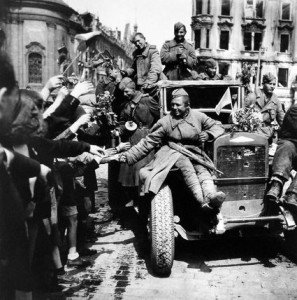May 1945 – Prague Uprising and Liberation
By Erin Naillon
Czechoslovakia during World War II
By 1945, Czechoslovakia had endured seven years of Nazi rule. No longer Czechoslovakia, it was now the Protectorate of Bohemia and Moravia and the Slovak Republic. Factories churned out weaponry for the German Army. Signs had to be printed in German, with the Czech names underneath. The country had a little national identity.
Terezin, Lidice and Ležáky
Far worse, deportations had taken their toll on the population. Terezín, a former military prison, was now a concentration camp and a way station for the far worse horrors of Auschwitz, Bergen-Belsen, and other death camps. The assassination of Reinhard Heydrich resulted in horrendous Nazi retaliation against the civilians of Lidice and Ležáky; a black-and-white photo shows four living men looking at rows of corpses in a field outside Lidice.
Czech Partisan Activities
The Czechs had been involved in a partisan activity for some years before 1945. A Czechoslovak Army was formed in France in 1940. Some men made their way to England, where they joined the RAF. Edvard Beneš, who had resigned as President of Czechoslovakia in 1938, was also based in London, heading the government-in-exile. Czech fighters were regarded as traitors to the Third Reich since the country was under German rule, so if caught, they were shot.
The Slovak Uprising
The Slovaks had an uprising in 1944 in the city of Banská Bystrica. Though joined by members of approximately 32 nations, the uprising was quashed by the Germans, with many of the partisans sent to concentration camps.
The Battle of the Rails
In the spring of 1945, rumors were swirling that Allied forces were nearing the city. The American Army was approaching from the west. The Soviet Army was moving in from the east. Groups of Czech fighters began the “battle of the rails,” in which they sabotaged railroads, train stations, German trains, and highways. On April 30 – 1, Karl Hermann Frank, SS Group Leader, aired a radio broadcast in which he promised violent retribution against possible uprisings. Frank knew how to do it; he was responsible for organizing the horrible events in Lidice and Ležáky in 1942. He ordered civilians to stay out of the streets and ordered German soldiers to fire upon anyone who refused to obey his orders.
The Prague Uprising
On May 5, Czech police officers burst into the radio station at Vinohradská Street and battled with the SS soldiers already occupying the building. Hearing the sounds of fighting, the announcer began to encourage the Czechs to rise against the Nazis. Resistance fighters in other parts of the city took over the Gestapo and SiPo headquarters. Civilians finally removed the hated German signs and began to attack and disarm the Germans (at extreme risk of being shot). Barricades were built in the streets. Utilities were cut off, disabling German communication. The Nazi puppet mayor, Josef Pfitzner, panicked and stated allegiance to the Czech National Committee.
It didn’t take long for German forces outside Prague to mobilize in aid of their comrades in the city. On May 6, the Germans retook the main radio station, but Czech partisans continued broadcasting from another base.
German bombers flew in on May 7 and bombed the city, causing the destruction of most of the Old Town Hall; the centuries-old building was almost completely gutted and had to be torn down. The top of the tower was also destroyed, and damage was caused to the famous Astronomical Clock. The Germans’ superior firepower gradually overwhelmed the Czech fighters, whose ammunition was
insufficient.
Much to the surprise of both sides, a division of the Russian Liberation Army (ROA), which was strongly opposed to Communism and had been allied with the Third Reich, suddenly changed tactics and pitched in against the Germans. The Army had the ammunition and tanks that the Czechs so badly needed and was instrumental in saving the city center. Unfortunately, the leader of the division, Andrei Vlasov, feared that the Czechs would betray him (some of the Communist Czechs had already captured some of his men to hand them over to the Red Army), and the division pulled out and headed west. (Vlasov and several other leaders of the Army were later captured and handed over to the Soviets; they were hanged for treason the following year.)
 On May 8, with Allied troops approaching from the west and east, the Czechs negotiated a cease-fire with the Germans. The situation was now critical; the Czechs lacked the machinery and the weaponry to continue fighting the Germans, and the city’s Old Town was in flames. Part of the cease-fire was a guarantee from the Germans that the city would not be harmed further. The Czechs knew that, with help on the way, the cease-fire would be far more beneficial to them than it seemed on the surface.
On May 8, with Allied troops approaching from the west and east, the Czechs negotiated a cease-fire with the Germans. The situation was now critical; the Czechs lacked the machinery and the weaponry to continue fighting the Germans, and the city’s Old Town was in flames. Part of the cease-fire was a guarantee from the Germans that the city would not be harmed further. The Czechs knew that, with help on the way, the cease-fire would be far more beneficial to them than it seemed on the surface.
A previous agreement between American and Russian forces stated that the Red Army would be the one to liberate Prague; however, some American Army forces had come as far as the suburbs of Prague, and some negotiators persuaded General Toussaint, commander in charge of the German forces, to agree to the cease-fire.
Liberation of Prague
On May 9, 1945, the Red Army entered Prague. The city had been saved; its currently UNESCO – protected monuments were, for the most part, intact. And the war was, now, finally over.
The bloodthirsty Frank, now stripped of any and all power, surrendered to the American Army in Pilsen the same day. In March and April of 1946, he was tried in Prague for war crimes. Five thousand people turned out to view his execution by hanging in Prague’s Pankrác Prison on May 22, 1946. His body was thrown into an anonymous grave in the city’s Ďáblice Cemetery.
The numbers who died in the Prague Uprising are still not completely known. 1,694 Czechs were killed; an additional 1,600 were badly injured. The ROA, with its last-minute intervention, suffered casualties of approximately 300 men (not counting those who were later handed over to the Soviets). About 30 soldiers in the Red Army lost their lives.
“To the unknown fighter.”
Visitors to Prague will see plaques everywhere, especially in the city center, bearing names and dates. These plaques commemorate the men and women of the city who lost their lives in the Prague Uprising and are placed at the locations where the deaths occurred. The dates of the person’s birth and death, if known, are engraved on the plaques. A few of them read, “To the unknown fighter.”



